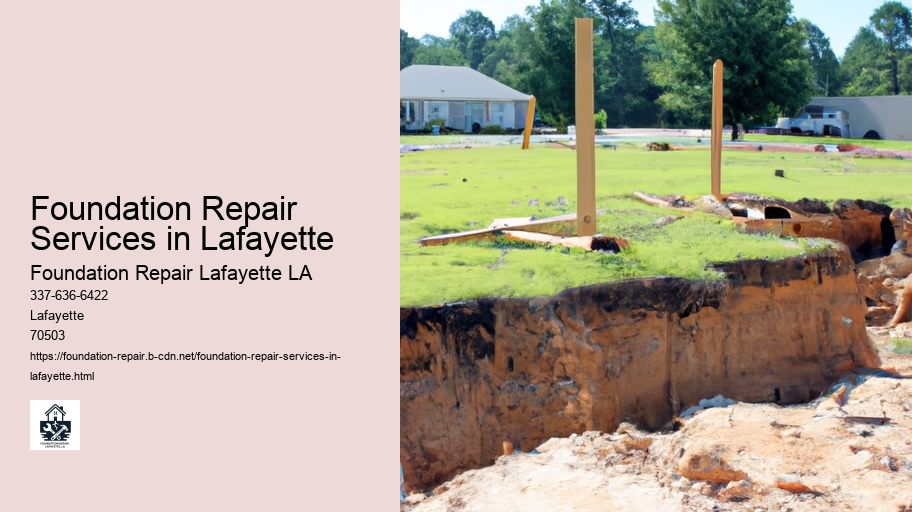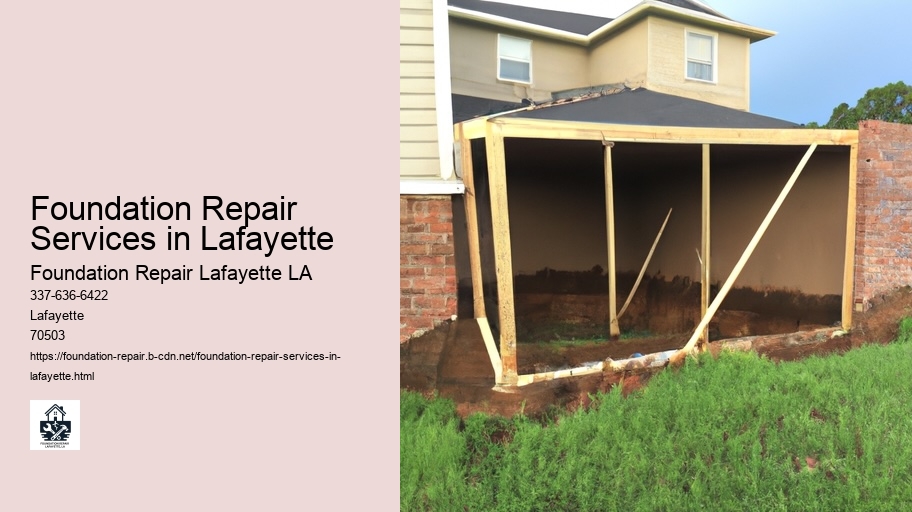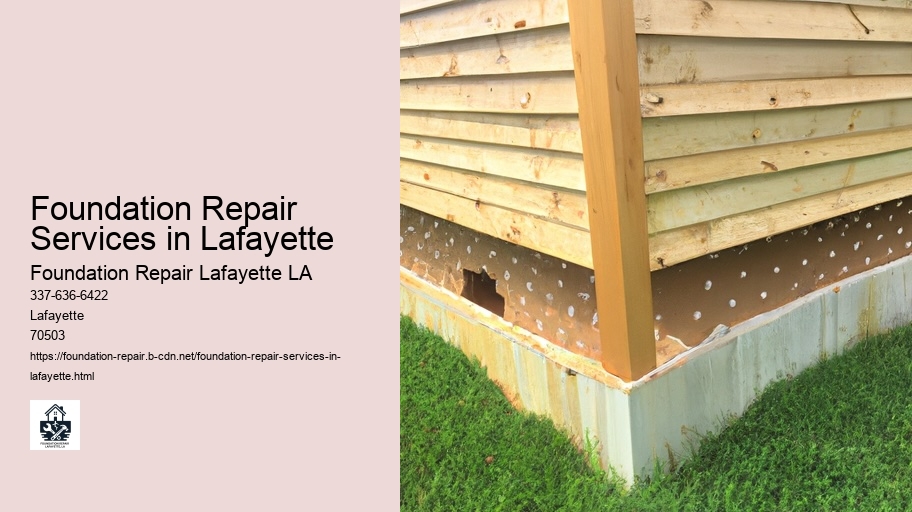

These systems direct water away from the foundation, preserving its integrity. Ensure that any verbal promises made during discussions are put in writing in the contract. Warranties and GuaranteesA reliable foundation repair contractor should offer warranties or guarantees on their work. Project TimelineWhen it comes to foundation repair in Lafayette, LA, understanding the project's duration and the scheduling process is essential.
This cycle can lead to cracks, shifting, and other structural damage. Additionally, tree roots seeking moisture can grow and create pressure against the foundation, leading to shifts and cracks. Dealing with Underground Water SourcesUnderground water can cause foundations to shift, leading to cracks and other structural issues.
Impact on Property ValueFoundation issues can significantly affect a home's value, making it crucial for homeowners to address these problems promptly. It expands when wet and contracts when dry, causing significant stress on foundations. Not only can foundation repairs stabilize the structure, but they can also enhance resale prospects. Foundation issues
Often, we add more piers to improve stability. By exploring these financing options, we aim to make foundation repairs more affordable and less stressful for homeowners in Lafayette, LA. We'll break down the typical expenses and the ways you can manage these costs.
This method addresses severe settlement issues and prevents further shifting. Start by walking around your home and taking note of any visible cracks in the walls, floors, or ceilings. Cracks in walls or ceilings, sticking doors, and uneven floors may indicate foundation problems. Avoid planting large trees or shrubs too close to the house. Our goal is to provide clear and actionable insights to help ensure long-term stability. Both these conditions can lead to cracks and other structural problems. Early detection and intervention can prevent larger, more expensive repairs down the road.
The mixture lifts and stabilizes the concrete slab. Monitoring for Future IssuesEven after repair, it’s vital to watch for signs of future issues. At FOUNDATION REPAIR LAFAYETTE, LA, we specialize in ensuring the stability and safety of your property. Check customer reviews and testimonials to learn about their reputation and past performance. It should also list the materials and equipment they will use. Effects of Foundation IssuesFoundation problems can lead to a variety of structural issues.
Typical Repair DurationsFoundation repair durations can vary depending on the type and extent of damage. This transparency helps build trust and can speed up the selling process. Permitting and RegulationsRepairing a foundation in Lafayette, LA, involves understanding local building codes and complying with zoning laws. Inspection: A detailed check to determine the necessary repairs. We offer free quotes to help you explore cost-effective solutions. Don't wait until the problem gets worse; let us help you protect your investment and ensure your home's foundation is solid and secure.
Once we understand the scope, we provide an estimated timeline. We utilize French drains, sump pumps, and other drainage solutions to manage water effectively. It’s also wise to check for water pooling around the foundation, as this can lead to soil erosion and cause issues. Soil moisture is crucial. Concrete slab repair What are affordable options for foundation repair? For example, a shed or playhouse under 200 square feet on movable foundations like piers or skids might not need a standard permit.
In engineering, a foundation is the element of a structure which connects it to the ground or more rarely, water (as with floating structures), transferring loads from the structure to the ground. Foundations are generally considered either shallow or deep.[1] Foundation engineering is the application of soil mechanics and rock mechanics (geotechnical engineering) in the design of foundation elements of structures.
Purpose[edit]
This section does not cite any sources. Please help improve this section by adding citations to reliable sources. Unsourced material may be challenged and removed. (January 2024) (Learn how and when to remove this message)
Foundations provide the structure's stability from the ground:
To distribute the weight of the structure over a large area in order to avoid overloading the underlying soil (possibly causing unequal settlement).
To anchor the structure against natural forces including earthquakes, floods, droughts, frost heaves, tornadoes and wind.
To provide a level surface for construction.
To anchor the structure deeply into the ground, increasing its stability and preventing overloading.
To prevent lateral movements of the supported structure (in some cases).
Requirements of a good foundation[edit]
This section does not cite any sources. Please help improve this section by adding citations to reliable sources. Unsourced material may be challenged and removed. (January 2024) (Learn how and when to remove this message)
The design and the construction of a well-performing foundation must possess some basic requirements:[2]
The design and the construction of the foundation is done such that it can sustain as well as transmit the dead and the imposed loads to the soil. This transfer has to be carried out without resulting in any form of settlement that can cause stability issues for the structure.
Differential settlements can be avoided by having a rigid base for the foundation. These issues are more pronounced in areas where the superimposed loads are not uniform in nature.
Based on the soil and area it is recommended to have a deeper foundation so that it can guard any form of damage or distress. These are mainly caused due to the problem of shrinkage and swelling because of temperature changes.
The location of the foundation chosen must be an area that is not affected or influenced by future works or factors.
Historic types[edit]
The simplest foundation, a padstone. The Ethnographic Open-Air Museum of Latvia
Earthfast or post in ground construction[edit]
Buildings and structures have a long history of being built with wood in contact with the ground.[3][4] Post in ground construction may technically have no foundation. Timber pilings were used on soft or wet ground even below stone or masonry walls.[5] In marine construction and bridge building a crisscross of timbers or steel beams in concrete is called grillage.[6]
Padstones[edit]
Perhaps the simplest foundation is the padstone, a single stone which both spreads the weight on the ground and raises the timber off the ground.[7] Staddle stones are a specific type of padstone.
Stone foundations[edit]
Dry stone and stones laid in mortar to build foundations are common in many parts of the world. Dry laid stone foundations may have been painted with mortar after construction. Sometimes the top, visible course of stone is hewn, quarried stones.[8] Besides using mortar, stones can also be put in a gabion.[9] One disadvantage is that if using regular steel rebars, the gabion would last much less long than when using mortar (due to rusting). Using weathering steel rebars could reduce this disadvantage somewhat.
Rubble-trench foundations[edit]
Main article: Rubble trench foundation
Rubble trench foundations are a shallow trench filled with rubble or stones. These foundations extend below the frost line and may have a drain pipe which helps groundwater drain away. They are suitable for soils with a capacity of more than 10 tonnes/m2 (2,000 pounds per square foot).
Lafayette (/ˌlæfiːˈɛt, ˌlɑːf-/, French: [lafajɛt]) is the most populous city in and parish seat of Lafayette Parish in the U.S. state of Louisiana,[3] located along the Vermilion River. It is Louisiana's fourth-most populous city with a 2020 census population of 121,374;[4] the consolidated city-parish's population was 241,753 in 2020.[5] The Lafayette metropolitan area was Louisiana's third largest metropolitan statistical area with a population of 478,384 at the 2020 census.[6] The Acadiana region containing Lafayette is the largest population and economic corridor between Houston, Texas and New Orleans.
Lafayette, Louisiana is a vibrant city rich in history, culture, and culinary delights. Here are some key facts about this city:
Origins and History
Originally established as Vermilionville in the 1820s by Acadian settlers from Nova Scotia, it was later renamed Lafayette in 1884 after the Marquis de Lafayette, a French hero of the American Revolution.
Lafayette developed as an agricultural community until the discovery of oil in the 1940s, which led to an economic boom and population growth, earning it the nickname "The Hub City."
Culture and Attractions
Lafayette is known as the "Heart of Acadiana" and is home to a diverse population with Louisiana Creole and Cajun backgrounds.
It hosts the Festival International de Louisiane, the largest international music and arts festival in the United States, celebrating Creole, Cajun, and French heritage annually in April.
Vermilionville is a living history museum showcasing the cultures of Native Americans, Africans, Creoles, and others from 1765-1890.
Cuisine
Lafayette has more restaurants per capita than any other American city, offering a wide range of Creole, Cajun, and other cuisines.
It is renowned for its authentic Cajun cuisine and has been called the "Happiest City in America" and the "Tastiest Town in the South."
Popular local dishes include boudin, cracklins, gumbo, étouffée, and po'boys.
Education and Economy
The University of Louisiana at Lafayette, established in 1898, is a major educational institution in the city.
Lafayette has diversified its economy beyond oil and gas, becoming a center for technology, healthcare, aerospace, banking, and retail.
Major companies headquartered or with a significant presence in Lafayette include Amazon, CGI, JP Morgan Chase, and Rouses Markets.
In summary, Lafayette is a culturally rich city celebrated for its Cajun and Creole heritage, vibrant festivals, renowned cuisine, and growing economic opportunities
Originally established as Vermilionville in the 1820s and incorporated in 1836,[7] Lafayette developed as an agricultural community until the introduction of retail and entertainment centers, and the discovery of oil in the area in the 1940s. Since the discovery of oil, the city and parish have had the highest number of workers in the oil and natural gas industry in Louisiana as of 2018.[8] With the issuance of a bond ordinance for a series of roads connecting nearby settlements; the establishment of the University of Louisiana System's Lafayette campus; and the continued diversification of its economy, Lafayette and its metropolitan area have experienced population growth since the 1840 census and was promptly nicknamed "The Hub City."[9][10] The city and parish of Lafayette are also known as the "Heart of Acadiana."[11]
As a result of its growth, the city and region have become major centers for the technology industry;[12][13] Lafayette also became a major center for health care and social services, aerospace, banking and retail.[14] Notable corporations with headquarters or a large presence in the Lafayette area have included Amazon,[15][16] Brookshire Grocery Company,[17] CGI,[18] JP Morgan Chase, Ochsner Health System,[19] Petroleum Helicopters International,[20] and Rouses Markets.[21]
Lafayette is home to a diverse population from Louisiana Creole and Cajun backgrounds.[22] In 2014, Lafayette was named the "Happiest City in America.”[23][24] The city and region's cultural icons include Alexandre Mouton House, Brandt House, Charles H. Mouton House, the Cathedral of Saint John the Evangelist, Daigle House, First United Methodist Church, Holy Rosary Institute, Hope Lodge No. 145, and Old Lafayette City Hall. Its educational institutions include the University of Louisiana at Lafayette, South Louisiana Community College, and Remington College.
We specialize in both services to meet your needs. If found, we replace or reinforce them with steel or treated wood. Concrete foundation These tools include:Laser levels for checking floor levelingMoisture meters to detect moisture build-upFoundation probes for deep inspectionAfter gathering data, we analyze the findings and provide a detailed report. One method is soil stabilization, where we treat the ground to reduce its expansive properties. Next, ensure proper drainage.
Understanding these zoning laws helps in planning and executing foundation repairs smoothly. Estimate and Timeline: We provide a clear quote and outline the project timeline. Advantages of Slab Jacking:Cost-effective for minor issuesMinimal disruption to the homeQuick process with immediate resultsHydraulic Piering SystemsHydraulic piering is used for homes with significant foundation settling or shifting. If you notice any signs of shifting or settling, don't hesitate to contact professionals.
Both are crucial for maintaining the integrity and safety of your home. It's important to review your policy and talk to your insurance provider to see if you're eligible. More extensive work, such as house leveling or pier and beam foundation repair, might require 1-2 weeks. If you see water pooling around your home's base or notice damp spots on your basement walls, this could point to foundation troubles.
These piers are hydraulically driven, providing strong and lasting support. Despite the expense, well-done repairs prevent future problems and can make a home easier to sell. First, check the soil around your home regularly. Key steps in Pier and Beam Repair:Inspect and replace damaged beams and joistsReinforce with steel or treated woodAdd or adjust piers for stabilitySlab Jacking and Mud JackingSlab jacking, also known as mud jacking, is used for concrete slab foundations.


If the ground slopes towards the house, regrading may be necessary, as this can lead to water pooling and potential damage. Gutters and downspouts should direct water away from the foundation to avoid excess moisture, which can cause soil to swell and put pressure on the foundation. Factors that influence these prices include the type of foundation, the severity of the damage, and local labor rates. We strive to complete repairs efficiently without compromising quality. We use specific techniques to manage this issue.
Hiring a Foundation Repair ContractorChoosing the right foundation repair contractor in Lafayette, LA is essential to ensure your home's safety and stability. Fortunately, homeowners have several financing options available. By staying vigilant, you can maintain a healthy foundation and protect your investment. Home equity loans or lines of credit are common choices, as they offer lower interest rates using your home as collateral.
This report includes the current condition, potential risks, and our recommended repair solutions. Affordable concrete leveling These soils swell when wet and shrink when dry, causing foundation instability. Cost ConsiderationsWhen thinking about foundation repair in Lafayette, LA, it's important to know the potential costs involved and explore various financing options. Make sure you get the warranty details in writing, and keep this document safe for future reference.
Proper soil maintenance, effective drainage solutions, and thoughtful landscaping are key strategies to maintain a stable foundation. Our experts look for signs of cracking, sinking, or shifting in the foundation. Water can erode soil under the foundation, creating voids that compromise stability. By following a few guidelines, you can help ensure the longevity and stability of your home.
Water the soil during dry periods to prevent it from drying out and shrinking, which can affect the foundation. We drive steel piers deep into the ground, reaching stable soil or bedrock. Preventive MeasuresPreventing foundation problems can save homeowners time and money.
Gaps around window frames or exterior doors are also typical symptoms.

For instance, certain areas have specific requirements about how far a structure must be from property lines, roads, or other buildings. Vetting Qualified ProfessionalsWhen hiring a foundation repair contractor, it's crucial to ensure they are qualified. In some cases, local or state programs may help with foundation repair costs, especially for low-income families. In severe cases, foundation issues can render a house uninhabitable until proper repairs are made. Understanding Repair ContractsBefore signing any contract, make sure you understand all the terms.
Affordable options include smaller, less invasive repairs like crack sealing or waterproofing. Ensuring water flows away from the house is crucial. Buyers are more likely to consider a home if they know the foundation is secure.
Another sign to look out for is uneven floors, which can sometimes be felt underfoot or seen with a rolling object like a ball. What criteria should be used to select the best foundation repair company? Our team at FOUNDATION REPAIR LAFAYETTE, LA, is committed to these standards.
Pay attention to any new cracks or changes. Regular checks are key.
Trees and large shrubs should be planted away from the foundation. Type of Foundation: Slab foundations can be quicker to repair than pier and beam types.
Are there any programs available that offer free foundation repair services? Slab stabilization Water pooling around your home's foundation can also be a telltale sign of potential issues.